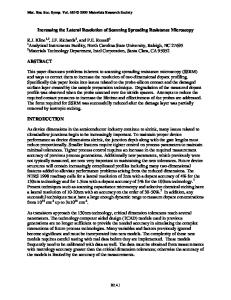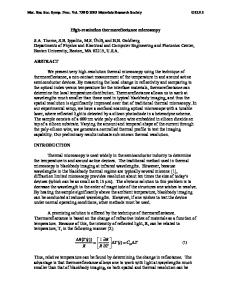Pulsed Force-Scanning Spreading Resistance Microscopy (PF-SSRM) for High Spatial Resolution 2D-dopant Profiling.
- PDF / 293,767 Bytes
- 6 Pages / 595 x 842 pts (A4) Page_size
- 98 Downloads / 948 Views
Pulsed Force-Scanning Spreading Resistance Microscopy (PF-SSRM) for high spatial resolution 2D-dopant profiling. P. Eyben, M. Fouchier, P. Albart, J. Charon-Verstappen and W. Vandervorsta IMEC vzw, Kapeldreef 75, 3001 Leuven, Belgium a also : KULeuven, INSYS, Belgium ABSTRACT Scanning Spreading Resistance Microscopy (SSRM) is now widely used for two-dimensional doping profiling with high spatial resolution. The need for a high force between the tip and the sample in order to obtain a good electrical contact, leads to a fast degradation of the tip (and the sample) while scanning. Tip damage is mainly due to the shear force occurring while scanning in contact mode at high forces leading to breakage (cleavage) of sharp tips or a rapid increase of tip radius (wear). The latter adversely affects the accuracy of the electrical measurements, as the contact radius is a determining parameter for quantification. The strong abrasive force also necessitates the use of tips composed of very hard material such as doped diamond, which has however a limited resistivity, and so far prevented the use of metallic probes. In addition the high force also prevents the simultaneous acquisition of high quality topography data. The solution to these problems is obtained by implementing the Modulated Force Principle (MFP). The latter consists of applying a variable (for instance pulsed) force while scanning, reducing the force during the lateral movement of the tip and synchronizing the electrical measurements with the high force periods. The latter results in lower lateral forces and introduces a quasi multi point contact mode. MFP also allows to obtain a better topography image by synchronizing the topography measurement with the low force part of the force cycle. The MFP leads to a drastic reduction of the surface and probe damage while maintaining high quality electrical data. The implementation of multiplexed detectors within the force cycle further enables the simultaneous acquisition of spreading resistance and topography during one scan, and/or the combination with multiple linear current detectors, capacitance sensors or tunneling current measurements. INTRODUCTION Scanning Spreading Resistance Microscopy (SSRM) is a powerful electrical characterization technique, based on Atomic Force Microscopy (AFM), which has been developed in recent years to probe the two-dimensional resistivity (and carrier) distribution in semiconductor devices [1][2]. In SSRM, a very small conductive tip is used to measure the local spreading resistance, which is intimately linked (directly proportional) to the local resistivity [3]. Scanning a cross section of the sample provides a two-dimensional map of the local spreading resistance with a spatial resolution set by the tip radius (typically 5-15nm). The main advantages of SSRM ly in its robustness, as it is far less sensitive to surface preparation than for instance Scanning Capacitance Microscopy (SCM) [4], its excellent dynamic range covering the entire dopant range of interest (1014-1020 at/cm3) with c
Data Loading...










